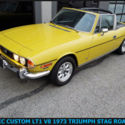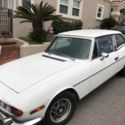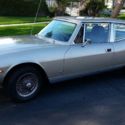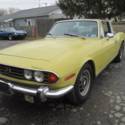RARE TRIUMPH STAG sport car Corvette MG Triumph Stag tr6 Corvette Audi
- Price:
- Location: Cape Coral, Florida, United States
- Condition: Used
- Make: Triumph
- Model: STAG
- Type: Convertible
- Trim: WIRE WHEELS
- Year: 1971
- Mileage: 36,000
- VIN: LE2718LBW
- Color: Yellow
- Engine size: V8
- Number of cylinders: 8
- Fuel: Gasoline
- Transmission: Automatic
- Drive type: RWD
- Interior color: Black
- Options: Leather Seats
- Vehicle Title: Clear
1971 Triumph STAG Description
SOLD AS A Mechanics Special Motor LockedNo Rust Florida car barn find stored inside for Many YearsSimilar to the in movie Diamonds are for ever007 James BoundTriumph StagFrom Wikipedia, he free encyclopedia| Triumph Motor Company |
| 1970–1977 25,939 made[1] |
| Giovanni Michelotti |
| Sports tourer |
| Triumph TR250 |
| 3.0LTriumph V8 |
| 100in (2,540mm) |
| 173in (4,394mm)[2] |
| 63.5in (1,613mm) |
| 49.5in (1,257mm) (hardtop) |
| 2,800lb (1,300kg) |
| Triumph 2000 |
TheTriumph Stagis a British car sold between 1970 and 1978 by theTriumph Motor Company, tyled by Italian designerGiovanni Michelotti.
Contents[hide]- 1Design and styling
- 2Engineering
- 3Production
- 4Mk1 and Mk2 Variants
- 5Replacement
- 6Unmade variants
- 7Classic status
- 8Use in popular culture
- 9References
- 10Further reading
- 11External links
Envisioned as a luxurysports car, he Triumph Stag was designed to compete directly with theMercedes-Benz SLclass models. All Stags were four-seaterconvertiblecoupés, ut for structural rigidity– and to meet new American rollover standards of the time– the Stag required aB-pillar"roll bar" hoop connected to the windscreen frame by a T-bar. A removablehardtopwas a popular factory option for the early Stags, nd was later supplied as a standard fitment.
The car started as a styling experiment cut and shaped from a 1963–4Triumph 2000pre-productionsaloon, hich had also been styled by Michelotti, nd loaned to him byHarry Webster, irector of Engineering at Triumph. Their agreement was that if Webster liked the design, riumph could use the prototype as the basis of a new Triumph model. Harry Webster, ho was a long time friend of Giovanni Michelotti, hom he called "Micho", oved the design and took the prototype back to England. The end result, two-door drop head (convertible), ad little in common with the styling of its progenitor 2000, ut retained the suspension and drive line. Triumph liked the Michelotti design so much that they propagated the styling lines of the Stag into the new T2000/T2500 saloon and estate model lines of the 1970s.
Engineering[edit]1972 StagThe initial Stag design was based around the saloon's 2.5-litre six cylinder engine, ut Harry Webster intended the Stag, arge saloons and estate cars to use a new Triumph-designedoverhead cam(OHC) 2.5-litrefuel injected(PI) V8. Under the direction of Harry Webster's successor,Spen Kingin 1968, he newTriumph OHC 2.5 PI V8was enlarged to 2997 cc (3.0 litres) to increase torque. To meet emission standards in the USA, key target market, he troublesome mechanical fuel injection was dropped in favour of dual Zenith-Stromberg 175 CDSE carburettors. A key aim of Triumph's engineering strategy at the time was to create a family of engines of different size around a common crankshaft. This would enable the production of power plants of capacity between 1.5 and 4 litres, haring many parts, nd hence offering economies of manufacturing scale and of mechanic training. A number of iterations of this design went into production, otably a slant four-cylinder engine used in the later Triumph Dolomite and Triumph TR7, nd a variant manufactured by StanPart that was initially used in theSaab 99. The Stag's V8 was the first
 UNIQUE 1973 TRIUMPH STAG ROADSTER WITH CUSTOM LT1 5.7 LITER V8 CORVETTE ENGINE!
UNIQUE 1973 TRIUMPH STAG ROADSTER WITH CUSTOM LT1 5.7 LITER V8 CORVETTE ENGINE!
Mileage: 8,537
 1973 Triumph Stag, Original 3.0 Triumph V8 engine runs great. Auto, AC, Hardtop,
1973 Triumph Stag, Original 3.0 Triumph V8 engine runs great. Auto, AC, Hardtop,
Mileage: 78,846
 Rare Triumph 1971 Stag with hard top and- no reserve-
Rare Triumph 1971 Stag with hard top and- no reserve-
Mileage: 81,625
 RARE 1971 Triumph Stag Mark1 convertible 4 seater
RARE 1971 Triumph Stag Mark1 convertible 4 seater
Mileage: 52,000
 1973 Triumph Stag~~~ Rare Original Engine~~~ only 430 exported to US
1973 Triumph Stag~~~ Rare Original Engine~~~ only 430 exported to US
Mileage: 71,568
 1973 Triumph stag v8 4 speed stick very nice no rust ! very very rare!
1973 Triumph stag v8 4 speed stick very nice no rust ! very very rare!
Mileage: 82,000
 1973 Triumph Stag MKII / Rare V8 Convertible / 69k original miles / Survivor
1973 Triumph Stag MKII / Rare V8 Convertible / 69k original miles / Survivor
Mileage: 69,500
 Triumph Stag(s)
Triumph Stag(s)
Mileage: 99,999
 Triumph Stag
Triumph Stag
Mileage: 37,760
 Triumph Stag 1973
Triumph Stag 1973
Mileage: 95000











